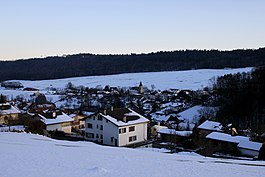Orvin
| Orvin | ||
|---|---|---|

Orvin village
|
||
|
||
| Coordinates: 47°10′N 7°13′E / 47.167°N 7.217°ECoordinates: 47°10′N 7°13′E / 47.167°N 7.217°E | ||
| Country | Switzerland | |
| Canton | Bern | |
| District | Jura bernois | |
| Government | ||
| • Mayor |
Maire Arlette Delémont |
|
| Area | ||
| • Total | 21.6 km2 (8.3 sq mi) | |
| Elevation | 669 m (2,195 ft) | |
| Population (Dec 2015) | ||
| • Total | 1,195 | |
| • Density | 55/km2 (140/sq mi) | |
| Demonym(s) | Orvinois | |
| Postal code | 2534 | |
| SFOS number | 0438 | |
| Localities | Jorat, Les Prés-d'Orvin | |
| Surrounded by | Corgémont, Sonceboz-Sombeval, La Heutte, Péry, Vauffelin, Biel/Bienne, Evilard, Lamboing, Nods | |
| Website |
www SFSO statistics |
|
Orvin is a municipality in the Jura bernois administrative district in the canton of Bern in Switzerland. It is located in the French-speaking Bernese Jura (Jura Bernois). Above it, there is a small year round resort, called les "Prés-d'Orvin".
Orvin is first mentioned in 866 as Ulvinc.
In 999 King Rudolph III of Burgundy gave Moutier-Grandval Abbey and its lands, including Orvin, to the Prince-Bishop of Basel. The village remained under the Bishop's direct control until 1295, when the Lords of Orvin received the village as a fief. They held the village until the end of the 14th century, after which it passed to the d'Orsans family and then the Lords of Rondchâtel. After the Rondchâtel line died out, the village returned to the Bishop's control who placed it under the ecclesiastical vogt of Biel. The first town charter of 1352 was expanded and revised in 1643 and confirmed by the Bishop in 1668. It remained in effect until the end of the Ancien Régime. Starting in the 14th century, the feudal levies of Orvin were part of a company from Erguel and under the control of Biel. However, between 1649 and 1852, they formed a separate company with its own banner. The military company became a major local corporation, which became quite wealthy through offering loans.
The old village church of St. Peter was part of the diocese of Lausanne, while the town was owned by the Bishop of Basel. St. Peter's was eventually demolished and a late-Gothic church was built in another location. That church was demolished in 1722 and replaced by the current Baroque church, which was decorated in 1916 by Paul Robert. The village accepted the Protestant Reformation in 1530. In the 17th Century, the population was afflicted by several witch trials.
...
Wikipedia




